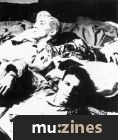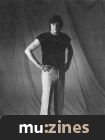Magazine Archive
Home -> Magazines -> Issues -> Articles in this issue -> View
Article Group: | |
Finding Sessions | |
Mark BrzezickiArticle from One Two Testing, November 1985 | |
Big Country's Mark Brzezicki tells how
Want to break into the session circuit? Big Country drummist Mark Brzezicki hands out the dynamite. Tony Bacon sets the fuse.

Mark Brzezicki works hard. Not content with being the drummer in Big Country, a hard-working Eighties success story if ever there was one, he's also one of the most in-demand session drummers you'll find on an album sleeve.
"A few months back I was at all three of the RAK studios in one day," says Mark by way of illustration. "Studio one in the morning with Suzi Quatro; studio two in the afternoon with Roger Daltrey; and studio three in the evening with Steve Harley. Very strange."
But, it would seem, not untypical of Mark's workload. Just in the past six months, Mark's done work for: The Cult (the complete new album, done at short notice after their drummer "either left or was sacked, I think sacked", and possibly some gigs too); Midge Ure (with Mark's brother Stephen on bass); Nils Lofgren (also with Stephen: a single, some album tracks, and "I know that Nils would have liked the whole of Big Country to have done a backing track with him"); some sessions with Duran Duran's Andy Taylor as producer (ex-Private Lives John Adams, and a new group called For Love Nor Money); and Pete Townshend (the soundtrack of his forthcoming "White City" film). And there's the already mentioned Daltrey and Harley LPs.
But what about Big Country? How does Mark still find time to do things like the group's recent soundtrack for "Restless Natives"? Well of course, he's a group man first and foremost, as he underlines when we meet at his home in Buckinghamshire to talk about the session world.
"I do give Big Country my all and my number one priority. But I don't consider myself a pop-star celebrity or any of that. I like to hang on to my musician side of things: endorsing the products, doing the sessions, things I've always wanted as a musician, rather than have my head in the clouds and pretend to be Simon Le Bon or someone. I'm not."
Indeed. Brzezicki comes across as a pleasant chap fired with the power of his drumming and intent upon the quality of his work. How could you criticise such a worthy and evidently talented musician? Well, let's see. How about, 'He only gets sessions since cos he's famous for being in Big Country'?
No go. He's been playing sessions since he was 16, long before Big Country exploited that Big Drum Sound.
"I like to think that Big Country has given people the chance to hear what I can do. I'd still be a drummer if I wasn't in Big Country, and hopefully I'd have broken into the wider session market anyway. But I wouldn't want to turn up to a session now and they say, 'We love Big Country, so can you play like Big Country on our stuff?' That wouldn't be doing me or them any good. It's no good cloning."
How do you get to be a session player? It's a simple question without a simple answer. There's luck, of course. With some people it's much like winning the pools: right time, right place, mega-bucks, no effort. Or...
"There's the long-winded way, which I've done," says Mark, "where you play with as many people as possible, learning all the time. In the early days I was always doing workingmen's type clubs, things people'd laugh at now. But it's work: you're not sitting indoors and drumming and annoying your neighbours. You can take your kit out and annoy the people down the club instead."
What was apparently annoying to others gave the teenaged Mark an opportunity to learn the discipline of playing like other drummers, whether pop, rock, ballads, bossa-nova, rock'n'roll... and then he'd go on to annoy some more people in the local studio.
At 16, Brzezicki and his group (including brother Stephen, then 14) went into Hallmark studio, a small 8-track demo dive in north-west London, to add their minutes of mayhem to recorded history. Much more significant than the noise they made was the impression Mark made on the studio's owner, Steve Hall. Mark could play, and made it clear that he wanted to learn more about playing in studios. Hall needed to have on call a constant stream of players to assist with what Brzezicki describes as "unglamorous" recordings. Crucially, before he left the studio, Mark asked if there was any work going — and for the next five or six years found himself constantly in and out of Hallmark studio.
What can the aspiring sessioneer learn from this tale? "Make yourself available, and want to do it," affirms Mark. "And if someone says they're in the studio, will you do it for them, instead of getting fussy and saying how much are you gonna pay me, I started off doing it for nothing, I was chuffed to be there. It's a matter of making a name for yourself, then being reliable, and being good at what you do. If you pass all those things, you'll get asked back."
Return visits are all very well — but from outside of the studio walls the whole business of session playing does tend to look like a closed shop.
"I think it is, unfortunately," Mark agrees. "People do get asked back, but it's the same people, and that makes what's usually a fixed cycle. It's a question of getting a break by hook or by crook. If there's any crack that you get into, then do it. I'll say it again: make yourself available. You've got to want to do it... I do believe you can do anything within reason if you really want to do it.
"It's amazing how many studios don't know of musicians, I'm always surprised. Studio people have said to me, 'Do you know any guitarists, Mark?' And like magic I'll quote names and numbers, friends of mine — and they're shocked when they turn up and are doing sessions for somebody famous. The studios tend only to know the people they know. So do fish for work. Give them your number, and you may get a ring."
No doubt Mark has made up for the original sessions that he played for nothing in order to get that crucial first break. Now, his session earnings are negotiated by his management, and based around Musicians' Union rates — the people who deal with these figures will push for double or treble session rates if they feel they can. That's their job. Most often there's a straight fee involved. More rarely there's the offer of "points" — a record's royalties "total" 100 points, and people involved may be offered a point or two for their services.
"It's a gamble if you go for points against a fee," says Mark. "If you're confident something's going to do well then a point is good to have. If you're on a single for Joe Bloggs and they're still sorting out the record deal, it's best to go for the cash.
"Most people prefer to pay musicians a fee — a daily rate, maybe, or an album rate. It's so much rarer to get points: that's usually reserved for if you're a member of the band when you'll receive your royalties split in your own negotiated way."
But it's not a subject that seems to hold much sway with Brzezicki. A just reward for your efforts and abilities, for sure. But being a good drummer, in the studio and on stage, is his aim: "It's wanting to be the top at what you feel you do best." This motivation within Mark is shared by the others in Big Country.
"Big Country has always been, for want of a better description, a slightly dodgy proposition from the word go," he reveals. "Stuart Adamson has always believed strongly that if the spirit's not in the group then there's no point in slogging for the profit's sake or whatever contractual reasons you might have got yourself into.
"Big Country thrives on good feelings within the band, and wanting to play together, rather than the 'oh no here we go again' type of thing. Bands do slog on past that point and produce awful albums. Big Country survives as long as the spirit, as Stuart calls it, is in the group. The spirit's still running very high."
When Big Country start rehearsing and recording their next album about the time you read this, Mark will be using his new Pearl kit for the first time. He got it in Japan in May, and describes it immediately as "much brighter" than his last kit.
The kit's not in general production yet — it should be early next year as part of the DX range. It's so new, in fact, that Mark has to get the tape measure out when One Two requests intimate details.
It's finished in maple wood, polished red ("I thought I'd be cheerful on the next tour") and is lined with fibreglass. Previously Mark has used a combination of wood and fibreglass Pearl drums in his kit, so thought that he might as well have the sonic properties of both combined in all the drums. The lining accounts for what Mark admits are the "weird sizes" of the kit: 22x19 bass, 8x8, 10x8, 12x11 and 13x12 toms, and 14x13 and 16x15 floor toms.
He'll be mixing with these new drums his old faithful Ludwig Black Beauty and Pearl free-floating snares, and four Tama Octobans ("although apparently Pearl are making me some in this new finish").
There's a barrage of cymbals, too, virtually all Paiste: hi-hats are 602 15in heavy bottom (on the bottom) and 2002 15in heavy bottom (on top); 505 15in crashes, 10in splash and 16in crash; 2002 18in crash; 20in Sound Creation bell ride; 22in Nova China-type (upturned bell); Ray Man 22in China-type; 18in Rude China-type; and an LP ice bell ("which looks like a German crash helmet").
"One of the people who came to your stand at Olympia to ask me a question said, 'Why are you using the 505s, they're the cheap ones'. But you shouldn't have that attitude — pick something you're happy with. I get my Paiste cymbals for free, but I prefer the sound of the 505s for my small crashes, I like them to have a bit of tone in them rather than being too clean and almost like white noise. If they sound good, then play them. Cheap cymbals can sound good."
Lastly, I wondered whether Mark considered it worthwhile passing on his knowledge to other One Two drummers. The answer, as I must admit I expected, was an emphatic yes. "I've asked Stewart Copeland what he uses, I've asked Phil Collins what he uses... that way you've got proof that certain drums are working for certain sounds. My splash cymbal that I use in the spaces in Big Country's music, the little ten-inch was directly borrowed from the Copeland attitude. It's good to learn off other people, it gives you a reference point."
More with this artist
More from related artists
Country Life (Big Country) |
Local Heroes (Big Country) |
The Biggest Country (Big Country) |
More with this topic
From Demo to Vinyl (Part 1) |
 Overtones |
Up and Running - The Nightcatchers |
Absolute Beginners - How To Get Signed |
The Managers |
Politics & Pop - Are They A Good Mix? |
A&R Men |
The Managers |
 Selling Your Songs - Songwriters's Special |
State Of Independents - Riff Raff, FON (Part 1) |
 Copyright or Copycat |
Making Studios Pay |
Browse by Topic:
Music Business
Publisher: One Two Testing - IPC Magazines Ltd, Northern & Shell Ltd.
The current copyright owner/s of this content may differ from the originally published copyright notice.
More details on copyright ownership...
One Two Tactics
Feature by Tony Bacon
Help Support The Things You Love
mu:zines is the result of thousands of hours of effort, and will require many thousands more going forward to reach our goals of getting all this content online.
If you value this resource, you can support this project - it really helps!
Donations for April 2024
Issues donated this month: 0
New issues that have been donated or scanned for us this month.
Funds donated this month: £7.00
All donations and support are gratefully appreciated - thank you.
Magazines Needed - Can You Help?
Do you have any of these magazine issues?
If so, and you can donate, lend or scan them to help complete our archive, please get in touch via the Contribute page - thanks!


















